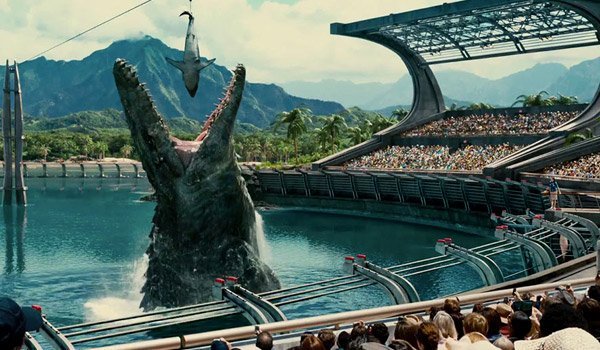“Consumers want them bigger, louder, more teeth.” So says the owner of the Jurassic World resort, where tourists can get up close and personal with some of the most impressive animals ever to walk the planet. The movie lives up to this maxim, packing in huge numbers of spectacular dinosaurs, as well as other marine and flying reptiles from the Jurassic and Cretaceous periods. This is the alternate universe of the original Jurassic Park taken to its logical and extreme outcome: a fully functioning theme park where the animals are genetically engineered, not only to bring them back from the oblivion of extinction, but also augmented and customised for a demanding public in search of even greater thrills. As we’d expect, however, things start to go wrong, and the dinosaurs live up to expectations as some of the most villainous movie monsters of all time, with appropriate disdain for their human creators.
The novelty of the original Jurassic Park movie depended heavily on the science underpinning the story: the (fictional) discovery of dinosaur DNA, the use of cloning to resurrect them and the ongoing revolution in palaeontology which revealed that dinosaurs were direct ancestors of birds – and were dynamic, behaviourally complex animals far removed from the lumbering lizard-like monsters of 1950s B-movies. Jurassic Park raised public awareness of palaeontology, boosted museum attendance figures and was a vehicle for introducing this new view of dinosaurs to a huge global audience, embedding cutting-edge science in the public imagination.
Cutting and pasting
However, science has taken a back seat in Jurassic World. We get to see some new animals, such as the shark-eating Mosasaurus – actually not a dinosaur, but an extinct aquatic lizard – but we don’t learn anything about them, nor do we get any updates to the dinosaur science that have taken place in the more than 20 years since the original movie. At one point, one of the characters exclaims “Nothing in Jurassic World is natural!” and this one phrase absolves the moviemakers of any need to try and make their dinosaurs work as living animals. After all, these are creatures that have been engineered from fragments of DNA that has been further diluted and altered by mixing it with that of other animals – so even if Jurassic World geneticists wanted to be as accurate as possible, the animals they create are arguably not true dinosaurs. This sophistry allows the resort’s scientists to create their new attraction, the lethal Indominus rex, a heady 50-foot-long (15m) mix of Tyrannosaurus, Velociraptor, tree frog and cuttlefish. It has superpowers that enable it to confound thermal imaging cameras and change colour, and is so smart it knows to claw out a tracking device from under its own skin. This may be a clever cinematic device to enable a suspenseful story, but from a palaeontologist’s perspective this idea of making all the dinosaurs to order is a disappointment: the movie represents a missed opportunity to try and impart at least some of the excitement that’s been generated by the many new discoveries that have fuelled dinosaur science since Jurassic Park.
Perhaps the most obvious absence is feathers. In the mid-1990s discoveries of spectacular fossils from China began to show that many dinosaurs were not only ancestors of birds, but also possessed that most bird-like of features. We now know that feathers characterised the majority of meat-eating dinosaurs and were used for display and insulation long before birds used their wings to take to the skies. The vast majority of popular science books, documentaries and other recent movies have now started to depict their predatory dinosaurs with coats of feathers: so why not Jurassic World? Acknowledging this fundamental shift in dinosaur biology would have been an easy win but seems to have been rejected because ‘scales are scarier’ – though I’m of the opinion that a Velociraptor with feathers would disembowel me just as effectively as one that had been plucked. Many other depictions of dinosaurs in the movie are actually less scientifically accurate than those given in the early instalments of the franchise, such as the Stegosaurus with its tail held down (it would have been held more horizontally) and quadrupedal dinosaurs like Triceratops galloping (these animals were not built for speed).
Missed opportunity
The whole idea of training the Velociraptors, which – as in the original movie – are around twice the size of the real things, is one I wouldn’t recommend. Although smart by reptile standards, fixing your steely glare on a razor-toothed, huge-clawed, agile pack-hunter with the intelligence and learning ability of an ostrich, and throwing it the odd dead rat for a treat, is likely to end in tears. As for being carried off by a flying pterosaur, which happens to several unfortunate tourists, some fundamental physics goes awry here: it seems highly unlikely that even a super-sized Dimorphodon with breast muscles the size of a turkey’s would be able be carry off your average-sized human, especially if that human had been indulging in some decent restaurants during their holiday.
More insidiously, in addition to the numerous palaeontological faux pas there’s an unpleasant anti-science undertone to the whole piece. None of the major characters are scientists, and the few scientists that are featured are amoral figures working at the behest of sinister corporate and military interests. In reality, the scientific community is largely motivated by the joy of discovery and of expanding our understanding of the universe around us, whereas Jurassic World concentrates only on negatives: when science goes bad. Yes, I know it’s a movie, but some positive role models would be useful especially at a time in our history when many of our major societal challenges – climate change, food shortages – need new scientists to answer them.
Despite some toe-curling moments with the science, I have to admit I enjoyed Jurassic World: it’s a fun, well-paced, action-adventure film with some great villains, jump-in-the-seat moments and terrific set pieces. However, you won’t learn anything new about dinosaurs, which is a shame. At heart, this is a classic monster movie pure and simple – it’s just that some of the monsters are based on now slightly dated depictions of once living, breathing animals.
By Paul Barrett
(BBC Culture)






